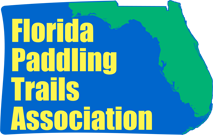
Paddling Safety
SAFETY GUIDELINES
General
Always wear a US Coast Guard approved personal flotation device (PFD) while on the water. The PFD should be in good condition and fit properly.
Always carry a whistle, preferably in your PFD.
In Florida, these items are nearly as important to wear as a PFD: wide brimmed hat, sunscreen, sunglasses. Hyperthermia is a real risk for much of the year here.
Leave a float plan with someone you trust, including your route, launch/take-out sites, boat description, and times of departure and return.
Check the condition of your boat/board and gear before departure.
Wear close-toed water shoes and quick dry clothing. During chillier months, pack a dry bag with added layers.
Transport your boat(s) or board(s) on your vehicle securely with multiple tie-downs and bow/stern lines.
Learn and practice self- and assisted rescues.
Be prepared should conditions become worse than expected.
Make sure your paddle craft is appropriate for the waters and weather you will be paddling in.
Carry plenty of water and food. Be sure you have easy access to water and a snack while paddling. Stay fueled and hydrated.
Additional items to pack: spray skirt, spare paddle, paddle float, tow rope, bilge pump, sunscreen, insect repellant, first aid kit, and a basic boat repair kit.
Be aware of your abilities and limitations, and don’t paddle beyond them.
When paddling in a group, never paddle beyond the abilities of your weakest paddler.
Take an on-water class to increase your paddling and safety skills. Find ACA-certified instructors in your area here.
Review the dozens of excellent instructional paddling videos that the ACA shares on canoeing, kayaking, and paddleboarding.
Navigation
Build your chart reading, GPS, and compass use skills.
Note where shipping channels and high traffic motorboat areas are and avoid them as much as possible. If you must cross a busy boating/shipping channel, do so efficiently and in a tight group if you’re paddling with others.
Waves often kick up in deep water channels, which is hard to see from shore. Be prepared for this.
Be aware that modifying your route may be necessary due to weather and extreme low tides, especially in the winter months along the Big Bend and Nature Coast.
Review this Navigation Rules for Paddlecraft booklet written by Jim Greenhalgh.
Communication
Carry at least one form of communication (cell phone, VHF radio, satellite messenger, etc.) that has coverage for the area you are paddling, a backup device, and spare batteries.
If paddling in a group, always review hand/paddle/whistle signals with all your paddlers. When it is windy, often times even a loud whistle cannot be heard upwind.
Weather
Always check the weather right up to departure time, and during longer trips. Pay attention to air and water temperature, wind speed and direction, and chance of rain or thunderstorms—in particular lightning. Wide open water in a thunderstorm is no place for paddlers!
Check the tide charts before departure, and be aware how weather, especially winds, affect the tides. Low tides on the Big Bend, Nature Coast, and Florida Bay areas of special concern in the winter months.
In colder months, be aware of the symptoms and treatment for hypothermia. Cold water can be extremely dangerous.
In warmer months, take frequent breaks to hydrate.
Rules of the Road
While paddling, keep your head on a swivel and maintain awareness of your surroundings.
STAY OUT OF THE WAY! Any vessel under 20 meters long should not impede the passage of a larger vessel.
Do not approach within 100 yards of any U.S. naval vessel.
Be aware of and avoid restricted areas.
Lights on another vessel are green on its starboard (right) side and red on its port (left) side.
Although paddlers generally do not have to stay within the channels, it's good to know the expected path of power and sailboats that do. Power and sailboats should keep red channel markers on their right and green markers on their left when returning, and the opposite when traveling downstream or out to sea.
Cross channels efficiently and in a tight group.
At night, a white light must be displayed to all oncoming traffic.
If you are not crossing a waterway, paddle close to shore.
To heighten your on-water visibility, consider adding reflective tape to your boat and paddles.


